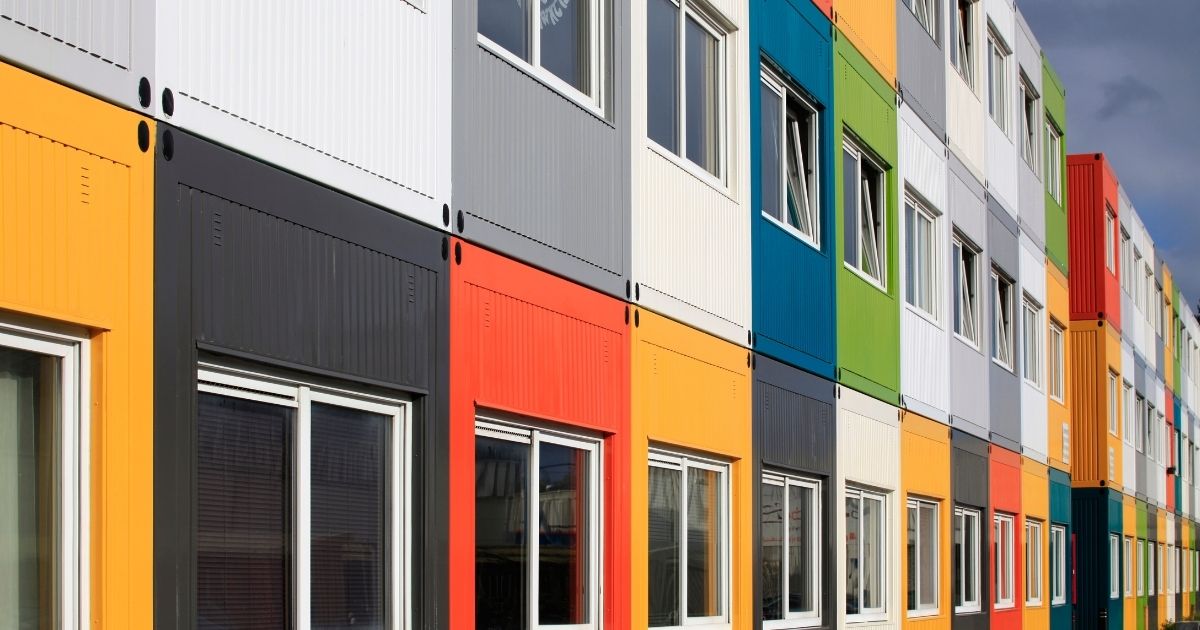CRJ Designer Homes is a locally owned, family operated building company. Since being established in 2006, Michael and his wife Gillian have made it their goal to build quality homes at exceptional prices, with inclusions that most would consider as an extra!
How to tell if a shipping container home is right for you

Have you ever seen an ad for a portable home on wheels, or an eco-friendly tiny house?
If you’ve watched alternate home videos, chances are you’ve come across houses built from shipping containers. Touted as a cheap alternative to building a traditional house, these modular homes are becoming more and more common. But are they really all they’re cracked up to be?
How do you build a house from shipping containers?
If you’re picturing a big steel box as a home, you’re not far off it! Shipping container homes make use of the large steel containers typically used to transport goods internationally. Sometimes bought by rural landowners for storage, homeowners are now taking these containers and turning them into the structural basis of a home. Typically 2.3 metres (8ft) square and ranging from 2.8 to 12 metres long, shipping containers can be used on their own as an addition to an existing dwelling, or be stacked together to create a full home.
Here’s five pros and cons to building a house from shipping containers in Australia, and how to tell if these homes are right for you.
Pro #1 Affordability
The biggest positive to building a house from shipping containers is that it is generally cheaper than a traditional house build. Because shipping containers are delivered pre-fabricated, a shipping container home will use significantly less building materials than a traditional house, with less labour required by your builder to put the house together. Just like traditional homes, a more complex build will have a higher price point than plainer designs, but if you keep it simple a shipping container house can be a cost-effective way to build your own home.
Pro #2 Build time
Another benefit of shipping container homes is that they are much quicker and easier to construct than a normal house. Depending on the complexity of the build, a house built from shipping containers could be completed in less than a month, rather than the standard 4+ months of a traditional build. Although you need to factor in the purchase and delivery of the containers, building a shipping container home is typically much quicker from initial consultation to move in than a traditional build.
Pro #3 Customisability

Houses made from shipping containers are considered modular – i.e. each shipping container is manufactured off-site and then installed together on your block. Because of this, they are very easy to customise and modify, with many owners starting out small before adding extra containers to their homes. The great thing about shipping containers is that they can be attached both perpendicular to or above other containers, giving you the option to spread out across your land or build-up to create a two-storey home.
Pro #4 Durability
Shipping containers are made to last. You wouldn’t want the new items you bought online being waterlogged while in transit across the sea! Constructed from high-quality steel with a waterproof seal, shipping containers are considered to be stronger than most traditional building materials and can withstand even the most severe weather conditions.
Pro #5 Mobility
Unlike a traditional house, shipping container homes are completely mobile, and are able to be transported between locations relatively easily. Just like moving a demountable classroom from school to school, shipping containers can be picked up section by section and transported to a new location should you ever need to move.
Con #1 Speciality
Tradies while the initial build of a shipping container home can be quite cost-effective, installation of wiring and fixtures can be more difficult than in a traditional home. Because shipping container homes are relatively new, not all tradesmen will be comfortable working in the space. You may have to pay extra to bring in electricians and plumbers who are familiar with the custom setups needed for these homes.
Con #2 Limited space


Being modular certainly has its advantages – but it also has its limitations. In most cases, rooms will be limited to the standard shipping container width of 2.3 metres, which is much cosier than traditional room sizes. While some owners opt to cut holes in the sides of containers and join them to create bigger spaces, the costs and complexity of such an endeavour are usually not worth it with these types of homes, nor is it keeping with the intended style of a shipping container house.
Con #3 Customisations require reinforcements
Many aspects of a shipping container house can be constructed by inexperienced homeowners – but reinforcing your structure isn’t one of them. Shipping containers are incredibly durable on their own, but once you start cutting holes for windows and doors the structural integrity of the room is significantly diminished. Be prepared for an experienced builder or contractor to reinforce walls and arches so your building doesn’t cave in on you.
Con #4 Limited choice of builders
While building a home from shipping containers is becoming more popular, it’s still considered an unusual build, and many building companies are inexperienced in constructing such a home. A number of Bundaberg builders simply won’t take on a project such as this, while others will have strict stipulations on the design and fit-out of the home.
Con #5 Layout and style
With more Australians turning to eco-friendly options and simple living, it’s no wonder that smaller, quaint homes are on the rise. However, you should be aware that when building a shipping container home, it will very likely have a much different layout than you’re used to. If you get claustrophobic in a caravan or have a desire for a sprawling indoor entertainment room, a shipping container home may not be for you.
Like any home, building a house from shipping containers will appeal to some homeowners and not to others. As local Bundaberg builders, you can rest assured that our staff know all about homes in the area and can answer any questions you have on building nearby.
If you want to know more about the options available to you for building your dream home, contact us today.
Say hello to CRJ

Get your free build assessment
Fill out our assessment request telling us what you're after in your new home & we'll provide you with a full home build & cost estimate.


